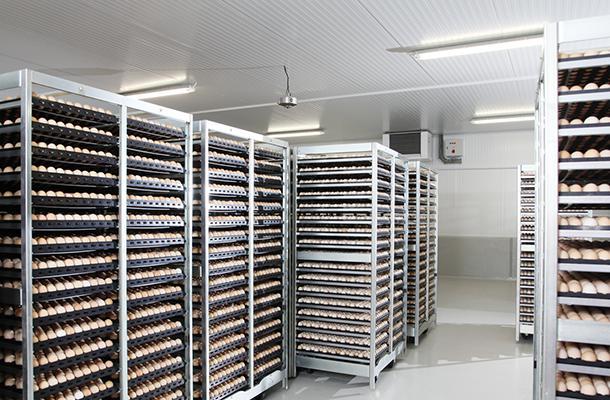Lessening the impact of prolonged hatching egg storage
Tags: Egg handling | Whitepaper
, 21 April 2020

Under normal circumstances, hatcheries try to avoid storing hatching eggs. The weekly supply of hatching eggs is based on the hatchery’s weekly setting capacity. Therefore, when eggs are delivered daily from breeder farm to hatchery, egg age at setting usually does not exceed 7 days, or 10 days when eggs are stored for 3–4 days at breeder farms prior to being transported to the hatchery.
Situations can however arise where, temporarily, fewer eggs might be set, for example due to foreseen seasonal changes in the poultry meat market (e.g. high demand during the festive season followed by a slump). Another, often unforeseen, reason for extended egg storage could be a ban on the transport of live poultry and eggs in a certain area to avoid the spread of a disease such as AI. Massive disruptions in the poultry product market as a result of war or as we saw during the Covid-19 pandemic can also lead to a reduction in chick placements and therefore an oversupply of hatching eggs.
When hatching eggs are supplied continuously, each day that they are kept in the storage room adds to the eggs’ age. This has a negative impact on hatchability and chick quality once the eggs are set. This article offers hatchery managers some practical measures for reducing the negative effects of prolonged egg storage.
However, it may first be worth considering other options for temporarily reducing the supply of hatching eggs to the hatchery. Hatching eggs could be sold or exported, older flocks could be culled earlier or, for younger flocks, forced moulting could be carried out. Needless to say, in times of oversupply, it does not make sense to send floor eggs to the hatchery or to be sloppy with egg grading.
The consequences of prolonged egg storage
- Reduced internal egg quality: watery albumen and weaker yolk vitelline membrane >
- Egg weight loss due to evaporation of water >
- Reduced viability of embryo and thus lower hatchability >
- Reduced chick quality (especially navel) and strong indications of reduced farm performance >
- Longer incubation time >
Best practice is to set hatching eggs 2–3 days after laying. Avoid storing eggs for longer than 7 days. If they need to be stored for longer than 10 days, there are some measures available for damage control.
3 tips to minimise the impact of prolonged hatching egg storage
Where prolonged egg storage (beyond 10 days) is the only option, the main aim is to maintain the highest hatch potential. To do this you need to preserve the quality of the albumen and the yolk and, most importantly, the quality and vitality of the embryo, as far as is possible.

Tip 1
- Create optimal storage conditions:
- Be aware of ‘sweating’ when eggs are moved to setter room for incubation or for heat treatment >
- Bear in mind that reducing the temperature of an egg storage room on a breeder farm might not be a good idea! >
Tip 2
- Store eggs sharp-end-up if possible; alternatively turn them 2 – 4x/day as is done during incubation >
Tip 3
Why it is sometimes better to cut your losses by selling hatching eggs to the egg industry
The above measures can definitely help to minimise the negative effects of prolonged egg storage, but best results will still be achieved by setting fresh eggs. If – when regular setting at normal capacity commences again – your egg store still contains large numbers of eggs, it is probably better to take the painful decision to get rid of your old stock by passing the eggs on to the egg industry, rather than resigning yourself to sub-optimal hatchability and chick quality.
For more details, read the in-depth article here.
What is your experience?
We'd love to hear from you: mail us at academy@pasreform.com
Written by Gerd de Lange
Senior Poultry Specialist
I welcome your feedback on this article - and if you require any additional information, please don't hesitate to contact me.